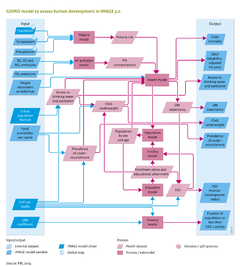Human development/Description: Difference between revisions
Jump to navigation
Jump to search
No edit summary |
No edit summary |
||
| Line 5: | Line 5: | ||
The Human Development Index (HDI), introduced in the UNDP Human Development Report 1990, to rank development achievement is a composite index of life expectancy, education, and income indices (UNDP 1990; UNDP 2010). The underlying indicators have been refined several times, over the years, while the three elements have remained the same. The index links to the three GISMO model components. | The Human Development Index (HDI), introduced in the UNDP Human Development Report 1990, to rank development achievement is a composite index of life expectancy, education, and income indices (UNDP 1990; UNDP 2010). The underlying indicators have been refined several times, over the years, while the three elements have remained the same. The index links to the three GISMO model components. | ||
== GISMO health model == | |||
The GISMO health model describes the causal chains between health-risk factors and health outcomes, (morbidity and mortality) taking into account the effect of health services. The mortality rate is modelled through a risk-factor-attributable component and a non-attributable component. Historically, the non-attributable component represents the remainder of mortality not covered by the risk-factors included. For future projections, this component is assumed to reduce by the regional average historical rates of reduction. | The GISMO health model describes the causal chains between health-risk factors and health outcomes, (morbidity and mortality) taking into account the effect of health services. The mortality rate is modelled through a risk-factor-attributable component and a non-attributable component. Historically, the non-attributable component represents the remainder of mortality not covered by the risk-factors included. For future projections, this component is assumed to reduce by the regional average historical rates of reduction. | ||
| Line 34: | Line 34: | ||
== header 2 ==GISMO education model | == header 2 ==GISMO education model | ||
The education model addresses future developments in school enrolment and educational attainment, including literacy rates, for three levels of education: primary, secondary and tertiary. The model tracks the shares of the highest completed education and the average years of schooling per cohort. The enrolment ratios per educational level are determined, using cross-sectional relationships with per-capita GDP (PPP). The ages at which children attain a certain educational level are assumed to be equal across all regions. Literacy rates are simulated by the share of the population aged 15+, who have completed at least their primary education. Furthermore, to take account of autonomous increases in literacy levels, those of the population between the ages of 15 and 65 are increase by 0.3%, annually. | The education model addresses future developments in school enrolment and educational attainment, including literacy rates, for three levels of education: primary, secondary and tertiary. The model tracks the shares of the highest completed education and the average years of schooling per cohort. The enrolment ratios per educational level are determined, using cross-sectional relationships with per-capita GDP (PPP). The ages at which children attain a certain educational level are assumed to be equal across all regions. Literacy rates are simulated by the share of the population aged 15+, who have completed at least their primary education. Furthermore, to take account of autonomous increases in literacy levels, those of the population between the ages of 15 and 65 are increase by 0.3%, annually. | ||
}} | }} | ||
Revision as of 12:11, 9 December 2013
Parts of Human development/Description
| Component is implemented in: |
|
| Related IMAGE components |
| Projects/Applications |
| Models/Databases |
| Key publications |
| References |
